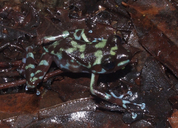|
Tsingymantis antitra Glaw, Hoegg & Vences, 2006
| family: Mantellidae subfamily: Mantellinae genus: Tsingymantis |
| Species Description: Glaw F, Hoegg , Vences M 2006 Discovery of a new basal relict lineage of Madagascan frogs and its implications for mantellid evolution. Zootaxa 1334: 27-43 | |
 © 2024 Devin Edmonds (1 of 5) |
|
|
|
Description Similar species: Due to its large size and unique habitat this species is unlikely to be mistaken with any other Malagasy frog (Glaw and Vences 2007). Distribution and Habitat Country distribution from AmphibiaWeb's database: Madagascar
Life History, Abundance, Activity, and Special Behaviors Calls: Unknown (Glaw and Vences 2007). Trends and Threats Comments
References
Glaw, F., and Vences, M. (2007). Field Guide to the Amphibians and Reptiles of Madagascar. Third Edition. Vences and Glaw Verlag, Köln. Vences, M. and Andreone, F. (2008). Tsingymantis antitra. In: IUCN 2008. 2008 IUCN Red List of Threatened Species. www.iucnredlist.org. Downloaded on 22 April 2009. Originally submitted by: Miguel Vences and Frank Glaw (first posted 2009-04-22) Edited by: Kellie Whittaker (2009-04-28) Species Account Citation: AmphibiaWeb 2009 Tsingymantis antitra <https://amphibiaweb.org/species/6818> University of California, Berkeley, CA, USA. Accessed May 3, 2025.
Feedback or comments about this page.
Citation: AmphibiaWeb. 2025. <https://amphibiaweb.org> University of California, Berkeley, CA, USA. Accessed 3 May 2025. AmphibiaWeb's policy on data use. |



 Map of Life
Map of Life